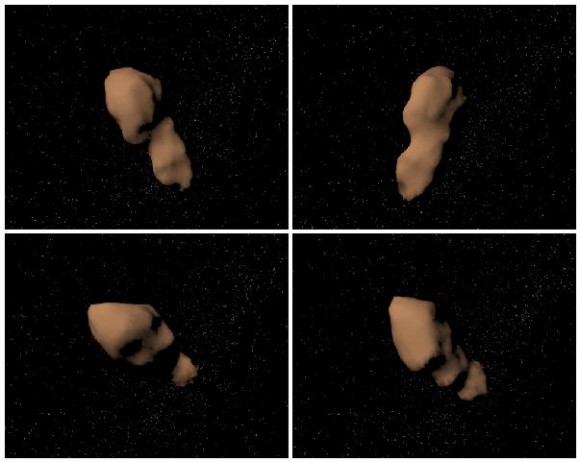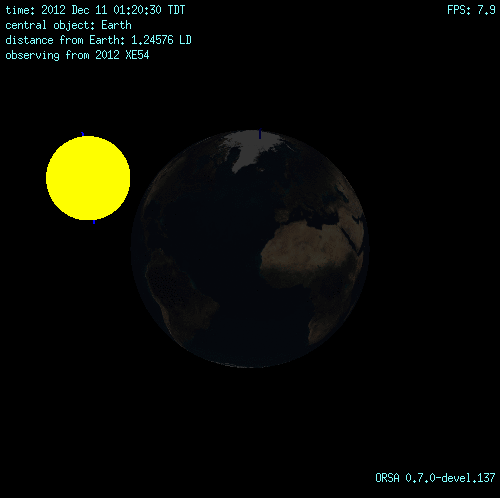Two Asteroids Will Buzz Past Earth on December 11
by NANCY ATKINSON | Universe Today
—
Four computer generated views of Asteroid Toutatis based on Goldstone radar imagery. Via NASA
A newly discovered small asteroid named 2012 XE54 and a long-studied giant space rock named Toutatis will buzz past Earth during the next 24 hours, and astronomers are already watching the skies. While there is no danger of either hitting Earth, scientists have much to learn from both. Asteroid 2012 XE54 was discovered over the weekend on December 9 and it will safely pass between the Earth and the Moon’s orbit at a distance of about 226,000 km (141,000 miles) or about .6 lunar distances. Closest approach will be just a few hours after this article was posted, at 10:10 UTC on Dec. 11. But already an interesting event has already happened with this 28-meter-wide asteroid: it was eclipsed by Earth’s shadow. This is quite a rare event, and was visible to astronomers.
This animation shows the Sun and the Earth as observed from the asteroid 2012 XE54. If this eclipse occurs, the asteroid will be in Earth’s shadow. Animation via Pasquale Tricarico
Pasquale Tricarico of the Planetary Science Institute had predicted that the asteroid would pass through the Earth’s shadow, creating an asteroid eclipse, an event that is similar to an eclipse of the full Moon by Earth’s shadow. At 01:22 UTC on December 11 the eclipse began, and it left Earth’s shadow at 02:00 UTC. Those watching the asteroid noted that the asteroid “disappeared” from its track, and then reappeared after leaving Earth’s shadow.
“In two images taken at 01:30:16 and 01:31:18, 60sec exposure, 2012 XE54 appeared as a very faint and long track, then… nothing. In the following images there is no visible track. Wonderful!” wrote Elia Cozzi from the New Millennium Observatory, posting in the mpml asteroid research group message board.
We hope to have images of the event when they become available.
4179 Toutatis, with a shape that has been described as a “malformed potato” will pass at a large distance of 6.9 million kilometers (4.3 million miles) away from Earth, or more than 18 times the distance from the Earth to the Moon.
It is a biggie, though at 4.46 kilometers (2.7 miles) long and 2.4 kilometers (1.5 miles) wide, and is considered a potentially hazardous asteroid because it makes repeated passes by the Earth, about every four years. In comparison, the asteroid that is thought to have destroyed the dinosaurs was approximately 10 km (6 miles) wide.
[smartads]
It’s closest pass will be covered by the Slooh Space Camera on Tuesday, December 11th, with several live shows on Slooh.com, free to the public, starting at 20:00 UTC (12 PM PST / 3 PM EST, find international times here — accompanied by real-time discussions with Slooh President, Patrick Paolucci, and Astronomy Magazine columnist, Bob Berman.
—
Read the rest of the article here: Universe Today














